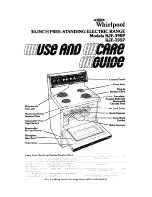
13
THERMOSTAT INSTALLATION
• A MILLIVOLT THERMOSTAT IS REQUIRED.
• Unplug stove from power outlet.
• Remove control board from stove.
• The two thermostat wires connect to the terminal block on the
lower left side of the back of the control board.
• Insert the wires in the terminal side and tighten the two screws.
MODES
TO SWITCH BETWEEN ANY OF THE THREE MODES THE STOVE
MUST BE SHUT OFF, THE NEW MODE SELECTED, AND THE STOVE
RESTARTED.
MANUAL MODE
• USE THIS MODE EXCLUSIVELY IF YOU DO NOT CONNECT AN
OPTIONAL THERMOSTAT
• In this mode the stove will operate only from the control panel
as detailed in the “Operation” section of this manual.
HIGH/LOW THERMOSTAT MODE
• USE THIS MODE ONLY IF YOU CONNECT A THERMOSTAT
• When engaged in this mode the stove will automatically switch
between two settings. When warm enough, it will switch to the
#1 or low setting. The convection blower will also slow to its
lowest speed.
• The Heat Level Advance setting on the bar graph will stay where
it was initially set. When the house cools below the thermostat
setting, the stove will switch to the feed rate of the heat level
advance setting.
ON/OFF THERMOSTAT MODE
• USE THIS MODE ONLY IF YOU CONNECT A THERMOSTAT
• In this mode when the home is warm enough the stove will shut
off. The blower will continue to run until the stove cools.
• When the home cools below the thermostat setting, the stove
will automatically restart and run at the last feed rate setting.
NOTE: When in “High/Low” or “On/Off” thermostat mode –
• Do not operate the stove higher than the #3 setting.
• Set damper control rod approximately 1/4” to 1/2” (7 mm to
13 mm) out. This will vary depending on elevation and weather
conditions. Observe stoves operation and adjust damper as
necessary.
OPERATING SAFETY PRECAUTIONS
PLEASE READ THIS!
a. Hot while in operation. Keep children, clothing, and furniture
away. Contact may cause skin burns.
b. If you notice a smoldering fire (burnpot full but no visible flame)
AND a heavy smoke buildup in firebox, immediately TURN
OFF the stove, but DO NOT unplug it. Do not open the door,
change the damper setting or tamper with any controls on
the stove. Wait until firebox clears, and blowers shut down, do
as instructed in “Pre-Start-Up Check” and “Building A Fire”
sections of this manual, then attempt to restart the fire. If the
problem persists contact your dealer.
c. WARNING: DO NOT ADD PELLETS TO THE BURNPOT BY HAND
AT ANY TIME, A DANGEROUS CONDITION COULD RESULT.
d. Attempts to achieve heat output rates that exceed heater design
specifications can result in permanent damage to the heater.
e. WARNING: DURING THE START UP CYCLE; 1) DO NOT OPEN
THE VIEWING DOOR; 2) DO NOT OPEN THE DAMPER MORE
THAN 1/4” (7 mm); 3) DO NOT USE THE FUEL FEED BUTTON
(UNLESS PRIMING THE AUGER AFTER RUNNING OUT OF
PELLETS). A DANGEROUS CONDITION COULD RESULT.
f. Pellets should be stored in a dry place. The pellets should not
be stored within 12” (305 mm) of the stove.
g. DO NOT STORE OR USE FLAMMABLE LIQUIDS, ESPECIALLY
GASOLINE, IN THE VICINITY OF YOUR STOVE. NEVER USE
A GAS OR PROPANE TORCH, GASOLINE, GASOLINE-TYPE
LANTERN FUEL, KEROSENE, CHARCOAL LIGHTER FLUID OR
SIMILAR FLUIDS TO START OR “FRESHEN UP” A FIRE IN THIS
HEATER.
h. WARNING: DO NOT OVERFIRE THIS STOVE. This may cause
serious damage to your stove and void your warranty. It also
may create a fire hazard in your home. IF ANY EXTERNAL
PART OF THE UNIT BEGINS TO GLOW, YOU ARE OVERFIRING.
Immediately press the “Power” switch on the control panel.
i. KEEP ALL LOOSE OR MOVEABLE HOUSEHOLD
COMBUSTIBLES, SUCH AS FURNITURE, DRAPES, TOYS, ETC.
AT LEAST THREE FEET FROM THE OPERATING STOVE.
j. Maintain proper ventilation. It is important that adequate
oxygen be supplied to the fire for the combustion process.
Modern houses are often so well insulated that it may become
necessary to open a window slightly or install an outside air
vent to provide sufficient combustion air.
k. Since heating with a solid fuel is potentially hazardous, even
with a well made and thoroughly tested stove, it would be wise
to install strategically placed smoke detectors and have a fire
extinguisher in a convenient location, near an exit.
l. Do not open stove door when operating unless necessary.
This will create a dirty, inefficient burn and could allow smoke
spillage or sparks to escape.
m. Do not permit operation by young children or those unfamiliar
with stove’s operation.
n. Do not service or clean this appliance without disconnecting
the power cord.
o. Do not abuse the door glass by striking, slamming or similar
trauma. Do not operate the stove with the glass removed,
cracked or broken.
p. If the stove is installed in a room without air conditioning, or
in an area where direct sunlight can shine on the unit, it is
possible this can cause the temperature of the stove to rise
to operational levels; one of the sensors could then make the
stove start on its own. It is recommended that the stove be
unplugged when not in use for extended amounts of time (i.e.
during the summer months).
q. DO NOT USE ABRASIVE CLEANERS AND NEVER CLEAN
WHEN HEATER IS HOT.













































